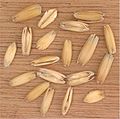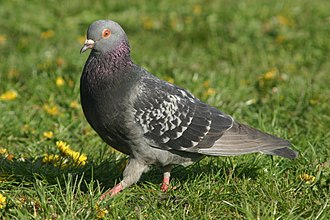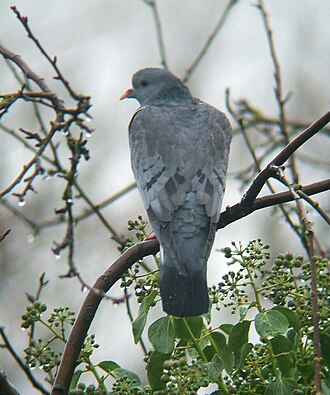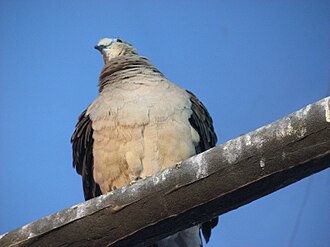AY Honors/Bird Pets/Answer Key
Template:Honor desc Template:AY Master Template:AY Master
1. Keep one or a pair of birds for at least six months.
Consider what you are doing carefully before becoming a pet bird keeper. Most of the birds commonly kept as pets live for decades. Parrots have the potential to outlive their keepers, with a lifespan that routinely reaches 50 years. Think about what you will be doing for the next 50 years and whether you expect you can care for another creature for that length of time. Pet birds that are given a lot of attention early in life get used to it. When the family situation changes and the bird no longer receives that amount of attention, it may begin to engage in self-mutilation.
Birds are incredibly intelligent and have a deep capacity for love. They also have a deep capacity for sorrow. You need to be mindful of this before you take on the responsibility of bird ownership.
2. Show you have completed one of the following:
a. If you have a cage bird, keep a record of its care for at least one month. Include food habits, water needs, cage cleaning, etc.
b. If you do not have a cage bird now but completed requirement #1 in the past, take care of some one else's bird for at least one week while they are on vacation, etc., and maintain a record of the required care.
Adventist Youth Honors Answer Book/Pet care records
3. Canaries
a. Give the names of four varieties of canaries.
Canaries are generally divided into three main groups, with each group having several varieties:
- Colorbred Canaries (bred for their many color mutations - Ino, Eumo, Satinette, Bronze, Ivory, Onyx, Mosaic, Brown, etc.)
- Type Canaries (bred for their shape and conformation - Border, Fife, Gloster, Gibber Italicus, Raza Española, Berner, Lancashire, Yorkshire, Norwich, etc.)
- Song Canaries (bred for their unique and specific song patterns - Spanish Timbrado, Roller, Waterslager (also known as "Malinois"), American Singer, Russian Singer, Persian Singer).
b. Give a brief history of the origin and development of canaries.
The canary is a domesticated form of the Wild Canary, (Serinus canaria) a small songbird in the finch family originating from Madeira and the Canary Islands.
Canaries were first bred in captivity in the 1600s. They were brought over by Spanish sailors to Europe. Monks started breeding them and only sold the males (which sing). This kept the birds in short supply and drove the price up. Eventually Italians obtained hens and were able to breed the birds themselves. This made them very popular and resulted in many breeds arising and the birds being bred all over Europe.
The same occurred in England. First the birds were only owned by the rich but eventually the local citizens started to breed them and, again, they became very popular. Many breeds arose through selective breeding.
c. Name and distinguish five seeds used in canary feeding.
d. Describe briefly the general care of canaries.
- Cage
- Do not keep a canary in a round cage, or it will develop psychological problems. A square cage will avoid this problem.
- Drafts
- Keep the canary away from drafts.
- Water
- Make sure the canary always has fresh water. A canary will die in as little as 15 hours without water.
- Food
- Use a high quality, fresh seed mix. If the seeds can germinate, they are fresh. You can test for this by wrapping some seed in a wet paper towel, placing them in a plastic bag, and storing in a warm place for about a week. If the seeds have not sprouted by then, they were not fresh. Give your canary a serving of greens every day. A healthy canary can consume half its body weight per day in greens. Use broccoli, romaine lettuce, collards, or even dandelion greens.
- Sanitation
- Replace the paper on the cage floor every day and clean the cage and perch weekly. Do not use perfumes or air fresheners around a canary. These birds are highly sensitive to airborne toxins, which is why they were used in mines - to detect deadly gases. Unfortunately, the gases were detected by the death of the canary, but it often gave the miners time to escape before succumbing themselves.
4. Parakeets or love birds
a. To what country are parakeets or love birds native?
Template:Adventist Youth Honors Answer Book/Problematic requirement Parakeets originally come from Africa and Australia. Love birds originally come from Africa.
b. Describe briefly their habits of feeding, nesting, and general behavior.
Parakeets: They don’t like to live together in colonies. The most that a large cage should accommodate is 2. They can however be kept with pigeons, pheasants or finches. They eat mixed varieties of seed such as budgie seed and oats. They also like their green feed such as spinach, cabbage and lettuce. Boiled egg can be added during the breeding season. They also need grass and palm leaves to build their nests.
Love Birds: They sleep in nests throughout the year and therefore should be provided with such or should be provided with the materials to weave their own. This includes palm leaves, papyrus, reeds, and grass. They eat a variety of seed such as sunflower seed, oats, canary seed and white, yellow, or red millet. They too can have boiled egg during the breeding season and are also very fond of green feed such as spinach, lettuce, etc.
5. Pigeons
a. Name and identify six varieties of pigeons.
| Columba livia (Rock Pigeon) | |
|---|---|
| Description | |
| The Rock Pigeon (Columba livia), is a member of the bird family Columbidae, doves and pigeons. The bird is also known by the names of feral pigeon or domestic pigeon. In common usage, this bird is often simply referred to as the "pigeon". The species was commonly known as Rock Dove until the British Ornithologists' Union and the American Ornithologists' Union changed the official English name of the bird in their regions to Rock Pigeon.
The Rock Pigeon has a restricted natural resident range in western and southern Europe, North Africa, and into South Asia. Its habitat is natural cliffs, usually on coasts. Its domesticated form, the feral pigeon, has been widely introduced elsewhere, and is common, especially in cities, over much of the world. In Britain, Ireland, and much of its former range, the Rock Pigeon probably only occurs pure in the most remote areas. A Rock Pigeon's life span is anywhere from 3-5 years in the wild to 15 years in captivity, though longer-lived specimens have been reported. The Rock Pigeon is 30-35 cm long with a 62-68 cm wingspan. The white lower back of the pure Rock Pigeon is its best identification character, but the two black bars on its pale grey wings are also distinctive. The tail is margined with white. It is strong and quick on the wing, dashing out from sea caves, flying low over the water, its white rump showing well from above. The head and neck of the mature bird are a darker blue-grey than the back and wings; the lower back is white. The green and lilac or purple patch on the side of the neck is larger than that of the Stock Dove, and the tail is more distinctly banded. Young birds show little luster and are duller. Eye color of the pigeon is generally orange but a few pigeons may have white-grey eyes. The eyelids are orange and are encapsulated in a grey-white eye ring. Feet are red to pink. When circling overhead, the white under wing of the bird becomes conspicuous. In its flight, behavior, and voice, which is more of a dovecot coo than the phrase of the Wood Pigeon, it is a typical pigeon. Although it is a relatively strong flier, it also glides frequently, holding its wings in a very pronounced V shape as it does. Though fields are visited for grain and green food, it is nowhere so plentiful as to be a pest. The nest is usually on a ledge in a cave; it is a slight structure of grass, heather, or seaweed. Like most pigeons it lays two white eggs. The eggs are incubated by both parents for about 18 days. The nestling has pale yellow down and a flesh-coloured bill with a dark band. It is tended and fed on "crop milk" like other doves. The fledging period is 30 days. | |
| Columba oenas (Stock Pigeon) | |
|---|---|
| Description | |
| The Stock Pigeon (Columba oenas) (formerly Stock Dove) is a member of the family Columbidae, doves and pigeons.
In the northern part of its European and western Asiatic range the Stock Pigeon is a migrant, elsewhere it is a well distributed and often plentiful resident. The three western European Columba pigeons, though superficially alike, have very distinctive characters; the Wood Pigeon may at once be told by the white on its neck and wing, but the Rock Pigeon and Stock Pigeons are more alike in size and plumage. The former, however, has a white rump, and two well-marked black bars on the wing, but the rump of the Stock is grey, and the bars are incomplete. The haunts of the Stock Pigeon are in more or less open country, for though it often nests in trees it prefers parklands to thick woods. It is common on coasts where the cliffs provide holes. Its flight is quick, performed by regular beats, with an occasional sharp flick of the wings, characteristic of pigeons in general. It perches well, and in nuptial display walks along a horizontal branch with swelled neck, lowered wings, and fanned tail. During the circling spring flight the wings are smartly cracked like a whiplash. The Stock Pigeon is sociable as well as gregarious, often consorting with Wood Pigeons, though doubtless it is the presence of food which brings them together. Most of its food is vegetable; young shoots and seedlings are favoured, and it will take grain. The short, deep, "grunting" Ooo-uu-ooh call is quite distinct from the modulated cooing notes of the Wood Pigeon; it is loud enough to be described, somewhat fancifully, as "roaring". The nest, though it is seldom that any nest material is used, is usually in a hole in a tree, a crack in a rock face, or in a rabbit burrow, but the bird also nests in ivy, or in the thick growth round the boles of linden trees. | |
Adventist Youth Honors Answer Book/Nature/Birds/Wood Pigeon
Adventist Youth Honors Answer Book/Nature/Birds/Band-tailed Pigeon
| Streptopelia turtur (Turtle Dove) | |
|---|---|
| Description | |
| The Turtle Dove (Streptopelia turtur) is a member of the bird family Columbidae, which includes the doves and pigeons.
It is a migratory species with a western Palearctic range, including Turkey and north Africa, though it is rare in northern Scandinavia and Russia; it winters in southern Africa. In the British Isles, France, and elsewhere in northwestern Europe it is in severe population decline. This is partly because changed farming practices mean that the weed seeds and shoots on which it feeds, are scarcer, and partly due to shooting of birds on migration in Mediterranean countries. Smaller and slighter in build than other doves, the Turtle Dove may be recognized by its browner color, and the black and white striped patch on the side of its neck, but it is its tail that catches the eye when it flies from the observer; it is wedge shaped, with a dark center and white borders and tips. When viewed from below this pattern, owing to the white under tail coverts obscuring the dark bases, is a blackish chevron on a white ground. This is noticeable when the bird stoops to drink, raising its spread tail. The mature bird has the head, neck, flanks, and rump blue grey, and the wings cinnamon, mottled with black. The abdomen and under tail coverts are white. The bill is black, the legs and eyerims are red. The black and white patch on the side of the neck is absent in the browner and duller juvenile bird, which also has the legs brown. The Turtle Dove, one of the latest migrants, rarely appears in Northern Europe before the end of April, returning south again in September. It is a bird of open rather than dense woodlands, and frequently feeds on the ground. It will occasionally nest in large gardens, but is usually extremely timid, probably due to the heavy hunting pressure it faces on migration. The flight is often described as arrowy, but is not remarkably swift. | |
| Leptotila verreauxi (White-tipped Dove) | |
|---|---|
| Description | |
| The White-tipped Dove (Leptotila verreauxi) is a large New World tropical dove. It is a resident breeder from the southernmost Texas in the USA through Mexico and Central America south to western Peru and central Argentina. It also breeds on the offshore islands of northern South America, including Trinidad and Tobago.
The White-tipped Dove inhabits scrub, woodland and forest. It builds a large stick nest in a tree and lays two white eggs. Incubation is about 14 days, and fledging another 15. The White-tipped Dove has an approx. length of 28 cm (11 in) and a weight of 155 g (5½ oz). Adult birds of most races have a grey tinge from the crown to the nape, a pale grey or whitish forehead and a whitish throat. The eye-ring is typically red in most of its range, but blue in most of the Amazon and northern South America. The upperparts and wings are grey-brown, and the underparts are whitish shading to pinkish, dull grey or buff on the chest. The underwing coverts are rufous. The tail is broadly tipped with white, but this is best visible from below or in flight. The bill is black, the legs are red and the iris is yellow. The White-tipped Dove resembles the closely related Grey-fronted Dove, Leptotila rufaxilla, which prefers humid forest habitats. The best distinctions are the greyer forehead and crown, which contrast less with the hindcrown than in the Grey-fronted Dove. In the area of overlap, the White-tipped Dove usually has a blue (not red) eye-ring, but this is not reliable in some parts of Brazil, Argentina, Bolivia, Paraguay and Uruguay, where it typically is red in both species. The White-tipped Dove is usually seen singly or in pairs, and is rather wary. Its flight is fast and direct, with the regular beats and clattering of the wings which are characteristic of pigeons in general. The food of this species is mainly seeds obtained by foraging on the ground, but it will also take insects, including butterflies and moths. The call is a deep hollow ooo-wooooo. | |
b. Describe their kind of food and general management.
Some of this information is included in the a. answers but this topic needs to be addressed better.
6. What are the laws in your state or country regarding the capture, breeding, role and/or export of cage birds? Be sure you are abiding by them while fulfilling the requirements of this Honor.
In the United States:
- It is illegal to export any wild-caught, native birds.
- It is illegal to import any bird belonging to a threatened species, unless the bird was bred at a captive breeding facility approved by the U.S. government (the U.S. government periodically publishes a list of qualifying facilities).
- If the importation of a species of bird causes excessive mortality, importation shall cease.
- It is illegal to import birds into the United States from countries where their export is forbidden.
In Canada:
- Follow regulations on crossing the border with pet birds. http://www.inspection.gc.ca/animals/terrestrial-animals/imports/policies/live-animals/pets/birds-us/eng/1326661204161/1326661329675
References
- http://www.robirda.com/cancare.html
- http://www.fws.gov/international/laws/law102.html
- http://www.aacc.ca/intro.htm Avicultural Advancement Association of Canada
- http://www.cites.org/










